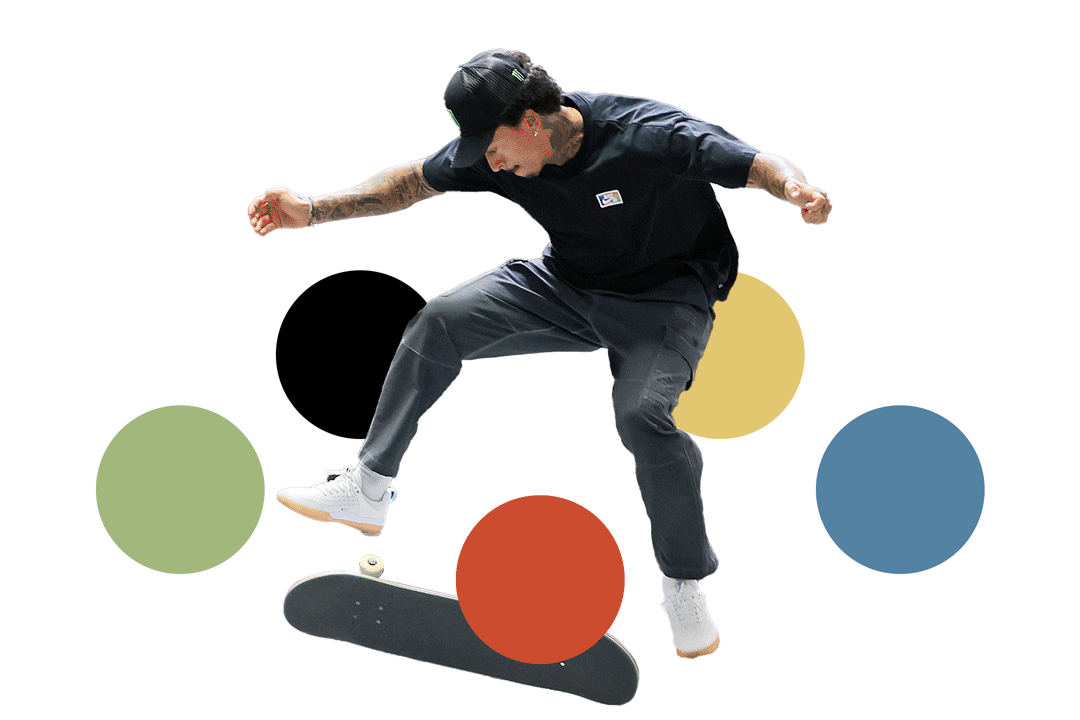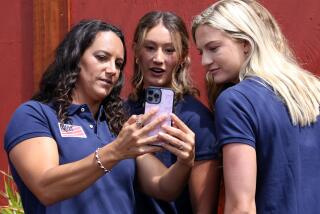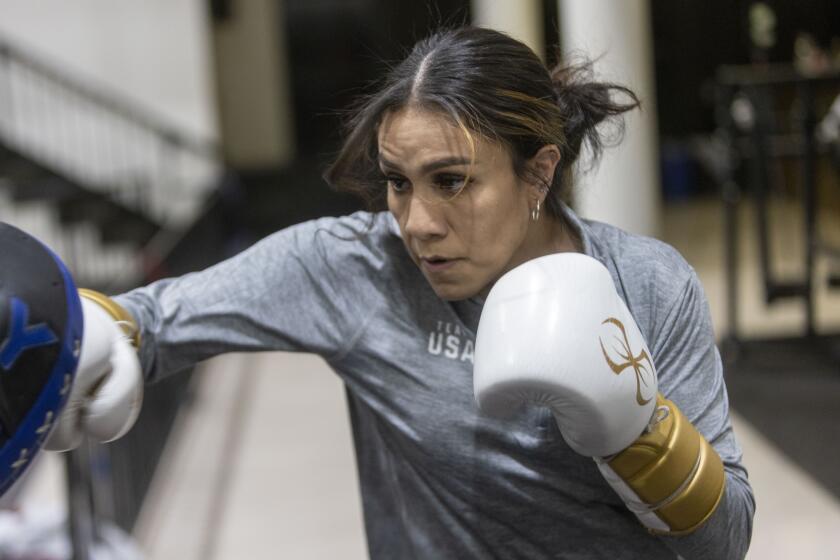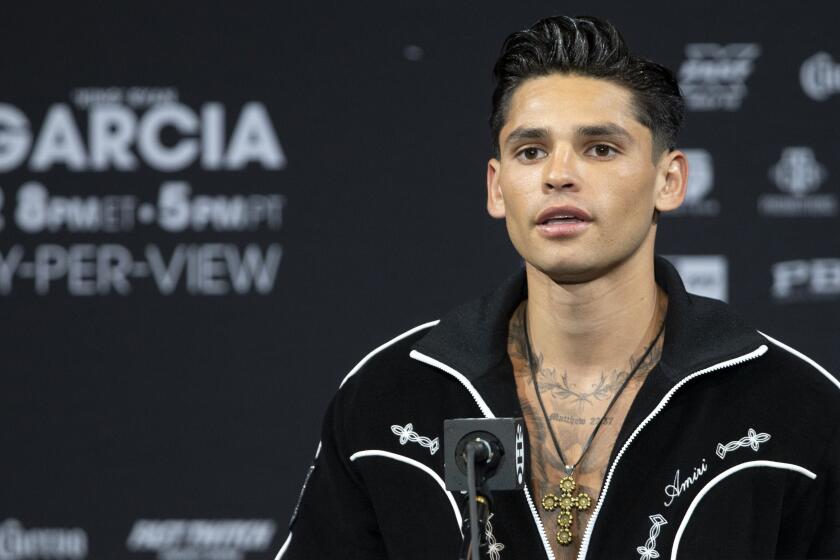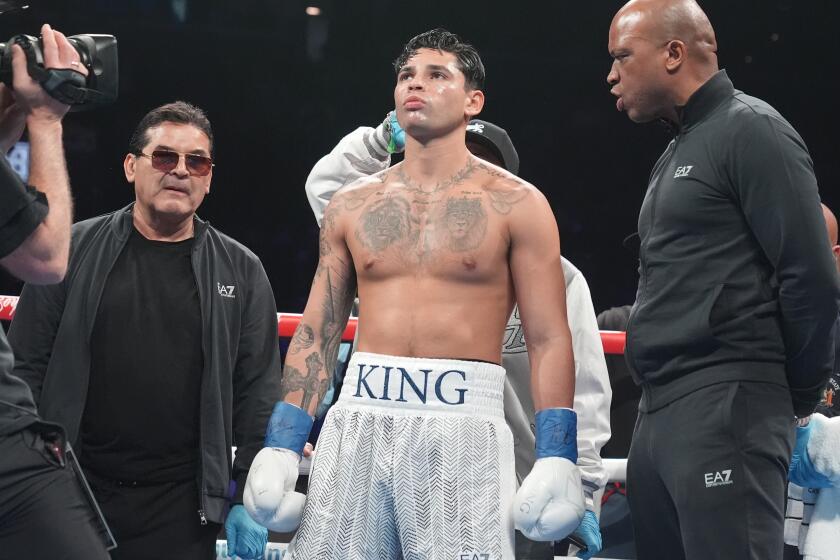Full of Fight
She calls it an arena, but the wrestling ring in Pam Adams’ small backyard in Santa Ana is a raggedy construction of used tires, plywood, old carpet padding and a blue tarp.
Scores of teenage boys from Los Angeles and neighboring counties come here each weekend to wrestle, using moves they’ve learned from watching pro wrestling on TV. Some of the more extreme teen wrestlers beat each other over the head with steel folding chairs and draw blood with baseball bats wrapped in barbed wire.
Backyard wrestling is one of the hottest sports for teen boys these days--and one of the most controversial. An estimated 1,000 federations--including the Backyard Brawlers in New York, Global Championship Wrestling in Chicago, and Backyard Hardcore Wrestling in Crawford, Colo.--have sprung up around the country in the last two years. Most members meet online, joining up with other kids in their area to practice and compete, using fire, thumbtacks and barbed wire in their matches to heighten tension and rev up the crowd. Wearing little, if any, protective gear, the combatants body-slam and pile drive each other, and some take swings with fluorescent light fixtures and throw mousetraps, hoping they’ll catch skin. Videos of the events are Webcast, traded and sold online.
The violence has alarmed many parents and has put professional wrestling organizations on the defensive, but the kids involved shrug off all that.
“Yeah, sure, we’re getting hit in the head with chairs and getting cut and everything and bleeding, but, you know, we walk away,” said Chris Jackson, a 19-year-old wrestler from Upland whose stage name is Mr. Fantastik. “Cuts heal, pain goes away. . . . We’re still nonetheless having fun.”
The total number of backyard wrestlers is small compared with the number of kids participating in sanctioned sports, but the rise in the popularity of the marginally supervised and often injury-inducing sport is catching many by surprise.
Some blame the World Wrestling Federation and World Championship Wrestling for starting wrestling fever and Xtreme Power Wrestling for raising the stakes. Much of what Stone Cold Steve Austin, the Rock and other wrestling stars do is choreographed--but that is lost on many backyard wrestlers.
Movies, music and the media are also seen as culprits in desensitizing kids to violence. Some point their fingers at rocker Marilyn Manson, saying he started blurring the lines between self-mutilation and entertainment with his onstage antics. Whatever the reason, many teens today have seen almost everything, and they’re hungry for something more.
“You can go to WWF and see them doing the moves, but this is different because it’s new. . . . They’re taking it to a new extreme, and kids like to see it,” said Veronika Vester, 17. Veronika is dating Kidd Krayz, a backyard wrestler who’s revered as one of the best “bleeders” in the Ventura-based Real Wrestling Federation. Its members are “their own little stars in their own town,” according to Veronika. “Everyone knows them.”
Veronika didn’t always enjoy seeing blood. When she started dating Kidd Krayz last January and went to one of his matches, she said: “I turned around. I couldn’t watch it--and then as time goes on, it’s just like the normal thing. . . . Now I’m out there yelling, ‘Yeah! Hit him!’ ”
Veronika has no interest in being a wrestler herself, she said, though she’s swatted people with the barbed-wire bat and once “cheese grated” another girl’s forehead.
She was one of about 30 kids who got together last Saturday for a match among members of the area’s two largest federations--Ventura’s RWF and California Backyard Wrestling, which is operated by Adams, a 43-year-old mother of two.
Wrestling Beats ‘Doing Drugs, Drinking’
Adams said she’s been watching wrestling for the last 25 years. Known to the wrestlers as “Pam Powers,” she is dressed in a panty-skimming black shirt dress, knee-high patent leather boots and a red fedora. Glittery blue makeup rings her eyes.
She lets the kids wrestle in her backyard because “I’d rather them be here than on the streets doing drugs, drinking, smoking pot, whatever,” she said. “I’m here. I know what they’re doing.”
And she trusts that the kids know what they’re doing when they get in the ring, even though most of them are self-taught. “They know how to prevent themselves from really getting hurt,” she said. “Of course, there’s gonna be accidents. There’s gonna be accidents when you play football, basketball, anything.”
But the “crimson masks” of blood that streamed down the faces of wrestlers Freddy Gabriel, 17, and Matt Heersink, 16, after they’d hit each other on the head with a barbed-wire baseball bat were hardly an accident. When Matt, known as the “Rock ‘n’ Roll Mechanic,” and Freddy, known as “Psycho Child Freddy Fido,” stepped in the ring, they knew they wouldn’t leave without drawing blood.
“None of these kids are made to do anything that they don’t want to do,” said Adams, who cleaned Matt’s wounds with the sprayer in her kitchen sink. “These kids usually know what they can take and what they can’t take and what the other kid can take.”
They can take a lot, apparently. Matt took at least four hard blows to his head with a steel folding chair. That was after he’d been clobbered on his noggin with a baseball bat, but before he took a fall into a bale of barbed wire.
For all of it, the fans went wild.
“It was a great reaction from the crowd. That’s what you’re really looking for,” said Matt, his head wrapped in a towel to sop up the blood from the gashes on his forehead and scalp.
“You better hide that from mom,” said Matt’s 14-year-old brother, Shane. An aspiring backyard wrestler himself, he had wrestled in a tamer match before his brother.
“Truthfully, I don’t like my boys to be in it, but it’s part of what they’re into now. What I was into as a teenager my parents didn’t like either, and I grew up to be a good person,” said Robyn Heersink, who had driven Shane to Adams’ house three hours earlier.
“As long as what they’re getting at home is wholesome, then as long as it’s supervised, I don’t think there’s anything wrong with it,” she said before the event began. Like most parents, she didn’t stay to watch.
‘Leave the Danger’ to the Pros
“I think parents need to be a little more proactive,” said WWF spokesperson Jayson Bernstein. “If there’s a ring in the backyard and your kid is climbing up the side of the house to jump off the roof, there’s gotta be some responsibility.
“We do our part,” he said, referring to the “leave the danger to us” public service announcements the WWF airs during every show. “What we do in the ring is entertainment. These are trained professionals. They’re very athletic. . . . They’re in a safe, standardized environment. It concerns us that children have been injured trying to do what we do.”
Xtreme Power Wrestling, the Van Nuys group that uses barbed wire and tacks and seems to have given extreme backyard wrestlers more than a few ideas, also runs a warning against backyard wrestling on the introduction to all its videotapes.
“Anybody that watches wrestling gets ideas from whatever wrestling they watch,” acknowledged Kevin Kleinrock, vice president of operations for the XPW. The XPW puts on live events in the San Fernando Valley several times each month and produces a weekly one-hour television show for the America One Network.
Backyard wrestlers are confusing theater with reality, according to Kleinrock. “When we have one of our so-called death matches, it’s not just about hitting someone with a chair. . . . It’s used as part of the [story line] to enhance the match,” he said. “It’s not about two guys in a backyard seeing who can take the most pain.”
Backyard wrestling is not illegal, according to Raul Luna, a public information officer with the Santa Ana police. “You have to have a victim to take action,” Luna said. Backyard wrestlers are willing participants--even if they are getting hurt.
Adams said police have come by her house twice in the eight months she’s been hosting California Backyard Wrestling--once for loud music, once because a wrestler was bleeding in her front yard and someone called to report it. The police did not issue citations in either situation.
Entertainment--Not a Sport
Professional wrestling, as practiced by the WWF, WCW and XPW, is seen in most states as entertainment, not as a sport. It is not regulated by the California Athletic Commission or other state agency. Just as professional wrestling is unregulated and growing in popularity, so goes backyard wrestling.
The WWF alone attracts more than 20 million viewers each week, according to Bernstein. While its core audience is 18- to 34-year-old men, one-third of its Monday night audience is under 17.
Backyard wrestler Freddy estimates he watches 40 hours of wrestling programming each week. “Lucha libre, WWF, women’s wrestling, everything. I’ve always loved it,” said Freddy, who has been watching it on TV for years.
Like a lot of backyard wrestlers, Freddy hopes to follow in the footsteps of WWF superstar Mick Foley, who used his backyard wrestling experience to go pro.
But Bernstein said Foley is the exception to the rule. “Mick is a rare talent,” he said. “If you wanna go down the path of becoming a WWF superstar, there’s a lot that goes into it first. One is being a responsible person--and jumping off your roof into a ring is not being responsible.”
No one jumped off the roof during Saturday’s event at Adams’ house. But for most of the fans, that didn’t diminish the event’s entertainment value. They’ll be back next month.
“Why do people keep coming back?” asked Freddy. “Because it’s funny, it’s entertaining. People love action, people love violence, people love funny stuff. It’s the fans. That’s what keeps us going.”
More to Read
Go beyond the scoreboard
Get the latest on L.A.'s teams in the daily Sports Report newsletter.
You may occasionally receive promotional content from the Los Angeles Times.
